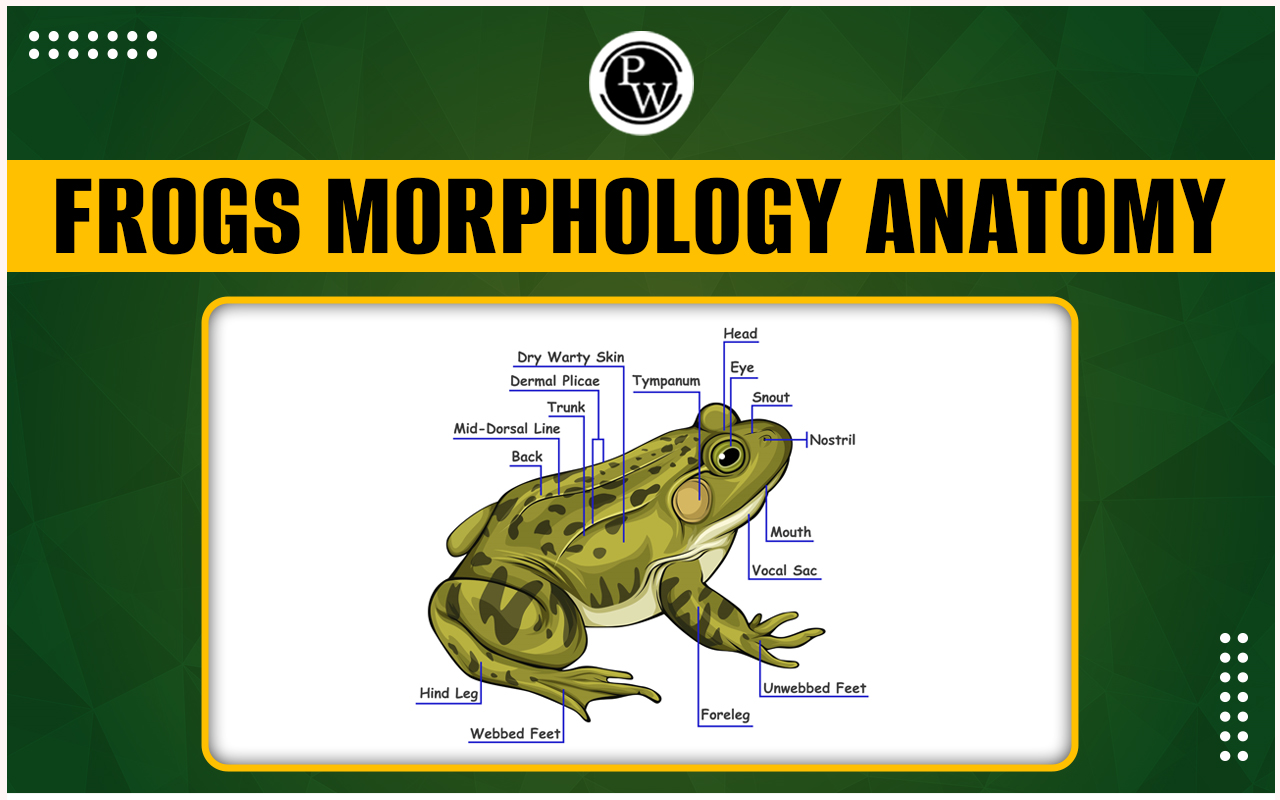
Frogs Morphology Anatomy: Are you curious to explore the anatomy and morphology of frogs? In this blog post, we will look in-depth into frogs' anatomy and morphology, including their structural adaptations and importance to the species. We'll compare and contrast frog anatomy and morphology, highlighting the species' unique characteristics. Get ready to explore the fascinating world of frogs and their anatomy and morphology!
Anatomy of a Frog
Frogs are complex and interesting animals with several unique anatomical features. A frog's body is divided into two regions: the head and the trunk. The head contains the mouth, eyes, nostrils, and ears. It also holds the frog's brain, which is responsible for movement coordination and the sense of taste and touch. The trunk contains several major organs, including the heart, lungs, and kidneys. The digestive system, including the oesophagus and stomach, is directly beneath the rib cage. The skeleton of a frog is composed of a skull, backbone, ribs, and limbs. Its skin is thin and mucous, which helps keep the frog's body moist. Frogs also have a webbed foot that aids in swimming and jumping. All these features combine to make the frog a unique and fascinating creature. Let's Study this organ in detail.Digestive System of Frog
The digestive system of a frog is a complex structure responsible for breaking down food into components that can be absorbed and used by the frog's body. A frog's mouth is filled with sharp, small teeth, allowing it to catch and swallow its prey. After swallowing, the food enters the oesophagus, which transports it to the stomach. Here, stomach acid helps break down the prey into smaller pieces, while digestive enzymes further break down the food into components that the small intestine can absorb. The small intestine is where most of the absorption of nutrients occurs. After passing through the small intestine, the food moves to the large intestine, where any remaining water and waste materials are reabsorbed. Finally, the waste materials are expelled through the cloaca.Circulatory System of Frog
The circulatory system of a frog is a closed-loop system that pumps oxygenated blood throughout the body. It is composed of the heart, blood vessels, and blood. The heart is a small, three-chambered organ under the oesophagus and behind the stomach. It is responsible for pumping blood throughout the body. The blood vessels consist of arteries, veins and capillaries. The arteries transport oxygenated blood throughout the body, while the veins transport deoxygenated blood back to the heart. The capillaries connect arteries and veins and exchange materials between the cells and the bloodstream. For aquatic animals, the skin acts as a respiratory organ. The process is called cutaneous respiration. Thus, the circulatory system of a frog is an efficient and important system for survival.Excretory System of Frog
The excretory system of a frog is responsible for eliminating metabolic wastes from the body. It is a complex system consisting of several organs and structures. The organs involved in the excretory system of a frog are primarily the kidney and the urinary bladder. The kidneys are the primary organ in the excretory process and remove metabolic waste from the bloodstream. The urinary bladder stores the waste until it is expelled from the body. In addition, the skin and the lungs also play an important role in the process. The skin acts as a filter and helps rid the body of toxins and other metabolic waste products. The lungs expel carbon dioxide, which is a by-product of cellular respiration. These organs and structures work together to help the frog excrete metabolic waste.Reproductive System of Frog
The reproductive system of frogs consists of both male and female reproductive organs. In frogs, the male reproductive organs are the testes, which produce sperm. The sperm is carried through the sperm ducts to the cloaca, which then releases the sperm into the water during breeding. The female reproductive organs are the ovaries, which produce eggs released into the water. Fertilisation of the eggs occurs externally when sperm from the male come into contact with the eggs in the water. The eggs then develop into tadpoles, which eventually transform into adult frogs.External Anatomy of Frogs
The external anatomy of frogs is quite complex and interesting to study. Frogs have several unique structures which allow them to live in and interact with their environments. These structures include skin, eyes, legs, feet, and tails. Frogs possess several organs, such as the digestive tract, lungs, heart, and reproductive organs. A frog's skin is covered in small bumps called tubercles and is usually moist to assist with moisture absorption from its environment. Frogs' eyes are typically large and protruding, and they possess several muscles that allow them to move their eyes in different directions. Frogs have four legs and webbed feet, which help them move through their environment and protect them from predators. Finally, frogs have a tail which is often longer than their body and can be used for swimming. By studying frogs' external anatomy, we can better understand how they adapted to their environment.Internal Anatomy of Frogs
The internal anatomy of frogs is a complex system of organs and body structures necessary for the amphibian to survive and thrive in its aquatic environment. Frogs have a unique anatomy that differs from other animals and includes a three-chambered heart, a large and highly efficient single-lung, a specialised digestive system, and unique reproductive organs. The heart is responsible for circulating oxygen-rich blood throughout the body, while the lungs are responsible for respiration and excretion. The digestive system of frogs is adapted to their particular dietary needs, which include insects, worms and other small aquatic invertebrates. Reproductive organs, such as the testes, ovaries and oviducts, allow frogs to reproduce and lay eggs. The anatomy of frogs is intricate and fascinating, and it is important to understand how the different organs and systems work together for the amphibian to survive and thrive in its aquatic environment.Difference Between Reptiles and Amphibians
The function of Frog Anatomy
Frogs are complex organisms that possess unique and vital anatomy. Frogs' anatomy includes many features that enable them to survive in their natural environment and complete a wide range of important functions. These functions include respiration, reproduction, and digestion. Frogs have a specialised respiratory system that allows them to breathe and extract oxygen from the environment while eliminating carbon dioxide. They also possess specialised reproductive organs, allowing them to produce and lay eggs. Frogs have a digestive system that helps them break down and absorb the nutrients they need from their food. These features are essential to the survival of frogs, as they help them to complete their necessary functions and ensure their continued existence in our world.Evolution of Frog Anatomy
Frogs are amphibians renowned for their remarkable ability to adapt and evolve to their environment. Over time, frogs have evolved an impressive anatomy that has enabled them to survive and thrive in various habitats. Frogs have a complex skeletal structure that includes a skull, vertebrae, ribs, and numerous joints that allow them to move and leap quickly. Frogs also possess a wide range of specialised organs and appendages, including a brain, lungs, four-chambered heart, and eyes that can move independently. Additionally, frogs have thick skin covered in mucus, providing them with protection from predators and parasites and helping them retain moisture. The anatomy of the modern frog has enabled it to become one of the most successful and widespread species on the planet. Morphology of a Frog It has a unique morphology that sets it apart from other animals. Its body is comprised of a head, trunk, and four limbs. The head is covered in an eye-catching assortment of colours and patterns and houses the eyes, ears, and nostrils. Its trunk is long and slender, with a distinctive ridge running down the back. Its limbs are short and powerful, allowing it to walk, swim, and leap easily. Its webbed feet are perfect for propelling it through the water. Its sticky skin is moist and slimy, allowing it to navigate wet surfaces easily. These features combine to make the frog an incredible example of evolution.Functions of Vitamin A B C D E
Comparison of Frog Anatomy and Morphology
Frogs have unique anatomy and morphology that separate them from other animals. Frogs have an elongated bodies with short, wide heads and short tails. The skin of a frog is thin and porous, allowing for respiration through the skin. The frog's mouth is typically large and contains a long sticky tongue used to capture prey. The front legs are generally longer than the back legs, allowing them to jump great distances. The hind legs are muscular and used to propel the frog forward in water or on land. Frogs have well-developed eyes, ears, and sensory organs. Their eyes have a unique nictitating membrane that protects the eye from the water. Frogs also have a unique muscular structure and skeletal system that gives them their jumping ability. Morphologically, some frogs have very bright colours, which warn predators or attract mates. Frogs have adapted to various environments and habitats, and their anatomy and morphology have evolved to allow them to survive in these conditions.Structural Adaptations of Frogs
Frogs are fascinating creatures whose unique structural adaptations enable them to live in varied habitats. Morphologically, frogs have adapted to their environment in several ways. They have a streamlined, hydrodynamic body shape with webbed feet and hands, which enable them to swim in the water and traverse land quickly. Frogs also have long hind legs, giving them powerful jumps to quickly move away from predators or capture prey. Anatomically, frogs are adapted to absorb oxygen from the water and air through their moist, permeable skin. This adaptation helps them to remain underwater for extended periods of time and save energy that would be spent on regular respiration. Furthermore, frogs have adapted to various climates, varying from cold, temperate habitats to desert climates. These adaptations have enabled frogs to survive and thrive in many different environments.Related Links
Frogs Morphology Anatomy <span style=
Q: What is the difference between a frog's anatomy and morphology?
A: Anatomy relates to the structure of an organism, whereas morphology refers to the form and function of the parts that make up the organism. Frogs have a unique anatomy and morphology adapted for life in water and on land.
Q: What type of skeletal system do frogs have?
A: Frogs have a highly specialised skeletal system that is adapted to both aquatic and terrestrial environments. The skeleton comprises numerous vertebral columns and ribs that provide support, as well as an array of bones that provide strength and flexibility.
Q: How do frogs breathe?
A: Frogs have both lungs and specialised air-breathing organs known as "buccal pumping" organs. The lungs are used for respiration in the water, and the buccal pumping organs are used when the frog is on land.
Q: What organs does a frog have for excretion?
A: Frogs have a highly specialised excretory system consisting of two organs: the kidney and the bladder. The kidney produces urine, which is then stored in the bladder until it is eliminated.
Q: What type of reproductive organs do frogs have?
A: Frogs have both male and female reproductive organs. Male frogs have testes, which produce sperm, and female frogs have ovaries, which produce eggs. The reproductive organs are located in the abdomen, and the eggs are released through the cloaca.
🔥 Trending Blogs
Talk to a counsellorHave doubts? Our support team will be happy to assist you!

Check out these Related Articles
Free Learning Resources
PW Books
Notes (Class 10-12)
PW Study Materials
Notes (Class 6-9)
Ncert Solutions
Govt Exams
Class 6th to 12th Online Courses
Govt Job Exams Courses
UPSC Coaching
Defence Exam Coaching
Gate Exam Coaching
Other Exams
Know about Physics Wallah
Physics Wallah is an Indian edtech platform that provides accessible & comprehensive learning experiences to students from Class 6th to postgraduate level. We also provide extensive NCERT solutions, sample paper, NEET, JEE Mains, BITSAT previous year papers & more such resources to students. Physics Wallah also caters to over 3.5 million registered students and over 78 lakh+ Youtube subscribers with 4.8 rating on its app.
We Stand Out because
We provide students with intensive courses with India’s qualified & experienced faculties & mentors. PW strives to make the learning experience comprehensive and accessible for students of all sections of society. We believe in empowering every single student who couldn't dream of a good career in engineering and medical field earlier.
Our Key Focus Areas
Physics Wallah's main focus is to make the learning experience as economical as possible for all students. With our affordable courses like Lakshya, Udaan and Arjuna and many others, we have been able to provide a platform for lakhs of aspirants. From providing Chemistry, Maths, Physics formula to giving e-books of eminent authors like RD Sharma, RS Aggarwal and Lakhmir Singh, PW focuses on every single student's need for preparation.
What Makes Us Different
Physics Wallah strives to develop a comprehensive pedagogical structure for students, where they get a state-of-the-art learning experience with study material and resources. Apart from catering students preparing for JEE Mains and NEET, PW also provides study material for each state board like Uttar Pradesh, Bihar, and others
Copyright © 2025 Physicswallah Limited All rights reserved.












